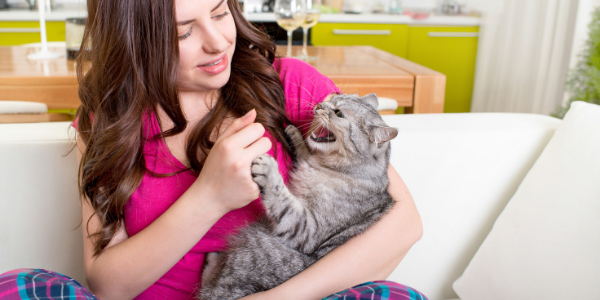 You’ve had a long day. You sit on the couch to relax and clear your mind with some guilty pleasure radiating from the television screen. Your kitty companion snuggles up on your lap and begins to shower you with purrs of contentment as you gently stroke her soft fur.
You’ve had a long day. You sit on the couch to relax and clear your mind with some guilty pleasure radiating from the television screen. Your kitty companion snuggles up on your lap and begins to shower you with purrs of contentment as you gently stroke her soft fur.
As your attention becomes wrapped up with what is happening in the TV show, you are jolted back to reality from the pain exuding from your hand, inflicted by the sharp teeth of your cat who was lavishing you with affection just moments before.
You ask yourself: Why would they do such a thing? Did I do something to cause them to react in such a way? Does my cat have a split personality, like Dr. Jekyll and Mr. Hyde?
These are all good questions and will be answered in this article. However, if you have recently been bitten by a cat, please review the article What to Do if You're Bitten by a Cat and tend to your wounds first.
Types of Cat Aggression
Recognizing Aggression in Cats
Cat Body Language Signs of Aggression
What to Do if You See Aggressive Signs
Why is Your Cat Biting?
How Your Behavior May Increase Aggression
What to Do if Your Cat Bites You
Types of Feline Aggression Directed at Humans
There are several categories of cat aggression towards humans. As I’ll explain further below, taking an inventory of your cat’s vocalization, facial expressions, and body postures, as well as all situations in which the aggression occurs, will be instrumental in determining the cause.
Aggression Due to a Medical Issue
Before considering behavioral issues as the cause of aggression, medical issues must be ruled out. Your family veterinarian will be critical in determining this. This is especially important with cats who have always had a calm temperament but are now displaying signs of aggression. Remember, cats are known for being very good at hiding pain. So, when they finally do bite, it could be an indication of intense pain.
Consider a cat who is suffering from a condition such as arthritis, a tooth infection, or an internal medicine problem like pancreatitis. These are all painful conditions that may result in an aggressive response when a cat is touched or think they will be. If your cat is sensitive to touch on certain areas of their body, like the right hip, make a note of this and make sure you share this information with your veterinarian.
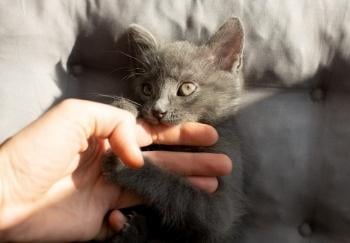
Petting-Induced Aggression (“Love Bites”)
Love bites are more nips than bites. They usually don’t break the skin and draw blood, other signs of aggression, like hissing, swatting, or growling are usually absent, and these “bites” happen most often when you are petting your cat. It leaves many of us to wonder why they are doing this.
Unfortunately, the term “love bite,” which is used commonly, is a misnomer — they are not displaying signs of affection but rather indicating they are done with the interaction. If the interaction continues despite this warning sign, it could lead to an actual bite.
Play-Related Aggression
Play-related aggression is a common behavior in kittens and young cats. It is predatory and aggressive behaviors directed towards humans in a playful context. The play usually involves inhibited biting (although the degree varies) and, occasionally scratching. It is often associated with stalking, pouncing, and hopping sideways. The target is usually moving objects, like hand and foot movements, or a person just walking through the house.
The ability to correct play-related aggression is good. However, if left unchecked or handled improperly, it can lead to more severe forms of aggression.
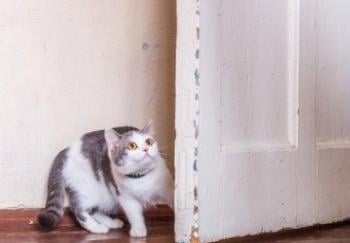
Fear-Related Aggression
Fear-related aggression occurs when a cat is exposed to someone or something that they perceive as a threat. It can also occur if the cat is frightened by a stimulus, such as a sound. The aggression escalates if there is no opportunity for escape. A cat displaying fear aggression is often experiencing anxiety about a situation that may or may not be apparent to you. Also, you can be the recipient of this type of aggression even if you’re not the one causing the fear.
A cat with fear aggression often displays a combination of defensive behaviors like:
- Ears flattened
- Head and body lowered
- Leaning away from the stimulus (distance increasing)
The aggressive behaviors often exhibited are:
- Piloerection (raised hackles)
- Hissing
- Mouth open, teeth exposed
- Growling
- Scatting
- Biting
- Scratching
Status-Related Aggression
Status-related aggression occurs when a cat is aggressive (typically bites or attacks) towards humans, other cats, even other household pets, in order to control a situation. They are usually cats who display a confident temperament and exhibit the following behaviors:
- Biting during petting or stroking
- Threatening postures when approached
- Biting and/or growling when picked up and moved
- Blocking entranceways (e.g., doors)
Redirected Aggression
Redirected aggression occurs when a cat becomes hyper-aroused by some stimulus that the cat cannot physically access. For example, another cat sitting just outside the sliding glass door, a titillating smell that escapes your limited smell receptors, or a squirrel scaling the tree outside the picture window. This lack of physical access causes the cat to become agitated. All of this is unbeknownst to you as you walk by and, subsequently, the cat redirects their pent-up agitation as aggression on you. This can also happen to other cats, and pets, in the household.
Redirected aggression can be difficult to diagnose because the circumstances that cause it are not often witnessed. Also, the recipient of the aggression seldom anticipates it and is usually traumatized by the aggression because it appears so out of context to them.

Territorial Aggression
Territorial aggression happens when a cat feels an “intruder” is invading their territory. Often the “intruder” is another cat brought to the house, but people and other pets can be victims of this type of aggression too.
With human visitors, cats displaying territorial aggression will typically approach or lunge at them, which may be accompanied by growling and hissing. Swatting or biting may occur even if the visitor stands still or attempts to move away.
It's important to remember that cat aggression is the symptom, not a cause. Cats aren't aggressive for no reason. They're reacting to something in their environment that's causing stress, fear, or agitation. Even instances where a cat truly attacks a person does not mean the cat has an aggressive nature.
The most gentle cat will act aggressively if they feel unsafe. And the most aggressive cat can often let that aggression go if the trigger is uncovered and addressed. So, don't think badly of your cat if they get aggressive. Think about possible triggers. And consider working with a certified feline training and behavior specialist for more support.
Recognizing Aggression in Cats
Cats communicate in the form of vocalization, body language, and scent. Of these three forms, certain body language, often in concert with vocalization, is used to express signs of aggression. For a complete review of feline communication and body language, check out Feline Communication: How to Speak Cat & Understand Cat Behavior.
In general, aggression refers to threatening or harmful behavior directed toward another individual or group.1 For the cat, aggression can take on many forms — from subtle body postures and facial expressions to violent attacks that cause physical harm. This information may be helpful in deciphering the triggers of their aggression, as well as providing you with warning signs before the next attack.
To understand why your cat is being aggressive, it is important to be able to differentiate the signs of aggression and their meaning.
It is also important to remember that no one type of communication takes place in isolation. Cat communication is a spectrum and can change at any moment. It is a process, not an event.
Cat Body Language Signals Related to Aggression
Body postures, facial expressions, and vocalization are ways cats communicate their frame of mind. Body postures concentrate on the messages conveyed by the whole body, combining some of the various body parts and body positions, like arching the back and leaning backward. Facial expressions focus on the messages revealed by combining some of the body parts located on the head, including ears, eyes, head carriage, mouth, and whiskers, like dilated eyes and flattened ears.
Cat Body Postures that Indicate Aggression
- Moving away (increasing distance)
- Running
- Piloerection ("raised hackles")
- Back arched and fur erect ("Halloween cat")
- Tail Lowered with the base and tip curved
- Tail twitching or thrashing
- Swatting
- Scratching
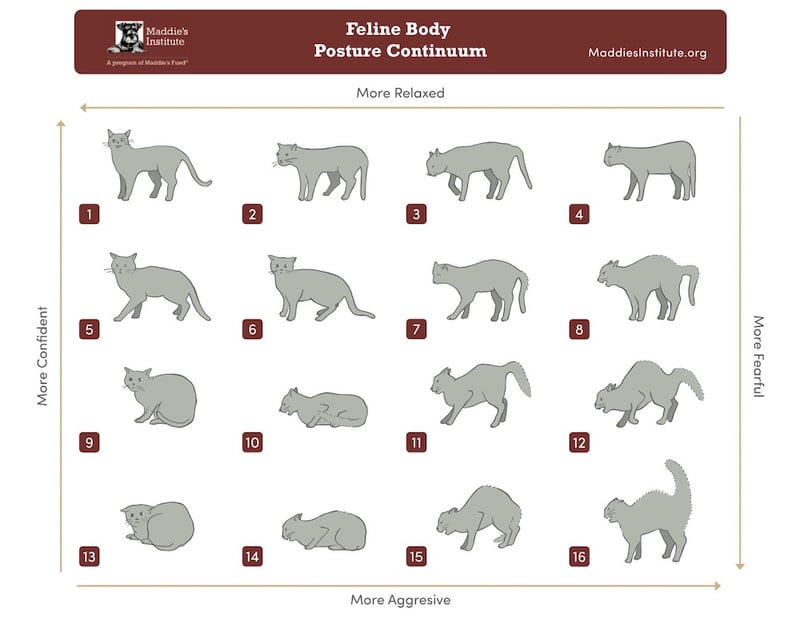
Cat Facial Expressions that Indicate Aggression
- Lowered head
- Ears flattened ("airplane ears")
- Ears raised or backward
- Ears twitching
- Pupils constricted (small)
- Staring
- Mouth open – teeth exposed
- Biting
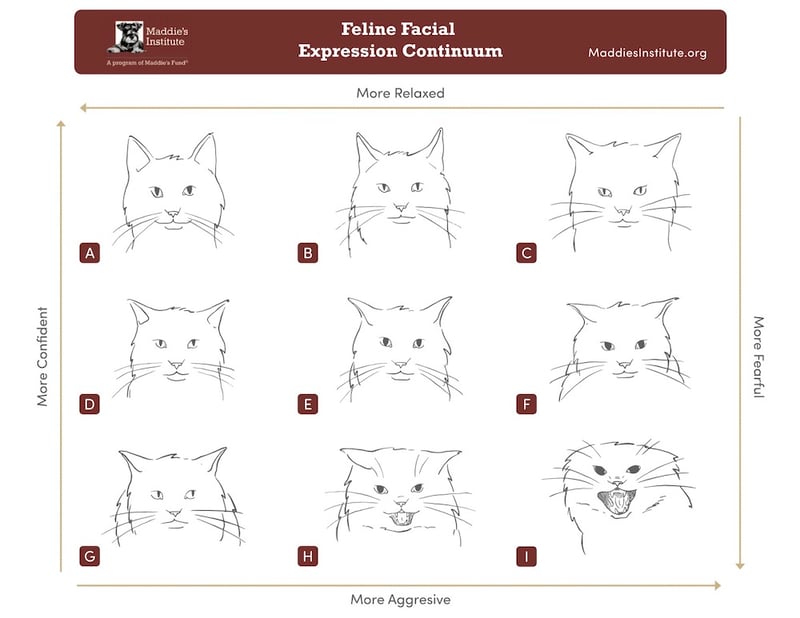
Cat Vocalizations that Indicate Aggression
- Growling
- Snarling
- Hissing
- Spitting
What Should You Do if You See Signs of Cat Aggression?
If your cat is exhibiting any of the above signs as you are interacting with them, it is important to stop and remove yourself. This behavior indicates that they are on the aggression spectrum, which could rapidly escalate to all-out attack mode, potentially injuring you.
If you feel you are about to be attacked by a cat, first and foremost, act calmly. Reacting with actions like quick movements and a loud voice may heighten the cat’s stress and prompt the attack. If you are able, leave the room and let them be. If you are not able to safely do this, distract the cat with a toy or an easily assessable object. If this is not possible, place a larger object, like a chair, between you and the cat.
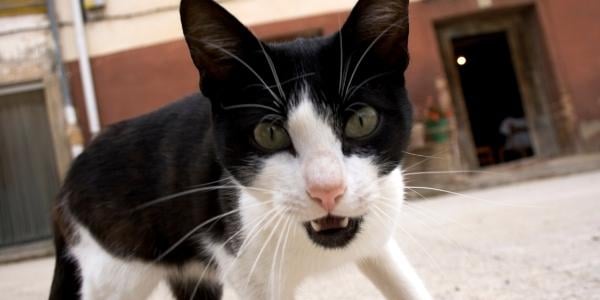 A perfect example of this happened to me while I was doing a behavioral consultation for a delightful couple regarding their cat who had, seemingly unprovoked, attacked the wife on a couple of occasions. As they were giving me a tour of their home and sharing their beloved cat’s favorite places and routine, I noticed that the cat was eyeing my feet with heightened interest. The twitching of his tail was increasing in intensity and his body posture was stiffening.
A perfect example of this happened to me while I was doing a behavioral consultation for a delightful couple regarding their cat who had, seemingly unprovoked, attacked the wife on a couple of occasions. As they were giving me a tour of their home and sharing their beloved cat’s favorite places and routine, I noticed that the cat was eyeing my feet with heightened interest. The twitching of his tail was increasing in intensity and his body posture was stiffening.
I calmly grab a long wooden skewer that was poking out of a container that was right next to me. I then distracted the cat with the end of the skewer using a playful gesture directed toward him. The cat immediately lost interest in my feet, his tail stopped twitching and his body posture became more fluid, and then he began to paw at the skewer in play. The clients and I were then able to safely leave the room without incident.
Why is Your Cat Biting You? Look at Your Cat's Body Language
To learn what a cat is trying to tell us, look at the various behavioral signs, then put each message together along with the context and environment to “hear” the message the cat is trying to convey.
Start by taking an inventory of the cat’s vocalization, facial expressions, and body postures, as well as all situations in which the aggression occurs. Using the example I used in the article intro, the bite occurred in the evening, while sitting on the couch and watching television. You were petting your cat while they were on your lap, not paying direct attention to them. When you think more about the situation, you realize that your cat rolled onto their back, you absentmindedly started petting their abdomen, they swatted at your hand, and, when your hand was not removed, it quickly led to a bite, followed by your cat making a speedy exit from your lap. The bite hurt a little, but it did not break the skin.
When your cat swatted your hand when you started petting her abdomen, she was sending a message to back off. When you didn’t, she did an inhibited bite of your hand, which is a sign of irritation to get you to stop it. In this scenario, the lessons from this interaction are:
- Be suspicious of your cat when she jumps onto your lap. Watch her carefully.
- Do not pet your cat’s abdomen, even if she flops on her back, seemingly inviting pets of her belly.
- Your cat provided a sign that she was not comfortable with the interaction (swatting your hand). Although the signs are often subtle, paying attention to her behavior and body language will provide you with clues about her mood and help in avoiding injury.
Human Behavior That Can Increase Aggressive Behavior in Cats
Can our behavior contribute to cats being aggressive towards us? Yes, although usually, it is unintentional.
Some examples are:
- Interacting with a cat when they are walking away from you.
- Often this means that they are not interested in interacting with you at that particular moment.
- It is safer to allow the cat to initiate the contact, approaching you and soliciting attention with something like a nudge of their head.
- Do not chase, grab, or hug a cat who is trying to get away from you.
- Ask visitors to not pursue your cat, especially if they are walking away.
- Reinforcement by playing with our hands.
- This is often started when they are kittens. Using our hands as “prey,” we delight when they wiggle their butt in anticipation, leap up and pounce on our hand, and then assassinate it with a chomp of their teeth. As kittens, this usually does not cause us any injury. But this will change as they become bigger and stronger. To prevent this reinforcement of aggression, only use toys to play with your cat, not your body parts.
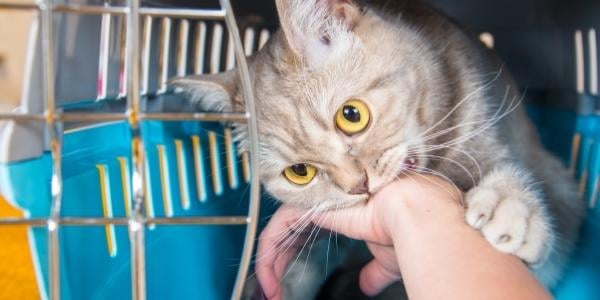
What to Do if Your Cat Bites You
Being bitten by your feline companion can cause harm not only physically, but emotionally too. In most cases, this behavior can be treated and significantly improved, if not resolved. Remember the following:
- If you have been bitten, tend to your wounds right away.
- If you need help on what to do, refer to the article What to Do if You're Bitten by a Cat.
- Rule out medical issues as a cause of aggression.
- Work with your family veterinarian to ensure your cat has a clean bill of health.
- Keep track of your cat’s vocalization, facial expressions, and body postures, as well as all situations in which the aggression occurs.
- Initially, you should avoid situations that trigger aggressive behavior until you receive appropriate counseling.
- Watch out for early signs of aggression and remove yourself from the situation so that you are not injured.
- If you need help, reach out to a veterinarian in your area who has expertise in behavior.
Ask your family veterinarian for a cat behavior consultant recommendation, or search the directory of the American Veterinary Society of Animal Behavior (AVSAB) or the International Association of Animal Behavior Consultants (IAABC).




